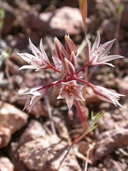Taxon Report
Allium nevadense Wats.Nevada onion |
 © 2006 James M. Andre |
Taxon Summary
Allium nevadense, commonly known as Nevada onion, is a perennial bulbiferous herb in the Alliaceae that is found in California and elsewhere. It occurs within Pinyon and juniper woodland (gravelly, and sandy), growing at elevations from 810 to 1700 meters. Allium nevadense is ranked 2B.3, Plants Rare, Threatened, or Endangered in California, But More Common Elsewhere; Not very threatened in California.Classification
|
Scientific Name: |
Allium nevadense Wats. |
|
Common Name: |
Nevada onion |
| Family: | Alliaceae |
| Element Code: | PMLIL021J0 |
| USDA Plants Symbol: | ALNE |
|
Synonyms/Other Names: |
|
Ecology and Life History
| Lifeform: | perennial bulbiferous herb |
| Blooming Period: Apr-May | Apr-May |
| Elevation: | 810-1700 (2660-5580) |
| General Habitats: | Pinyon and juniper woodland |
| Microhabitat: | |
| Microhabitat Details: |
Conservation Status
| CA Rare Plant Rank: | 2B.3 |
| Global Rank: | G4 |
|
State Rank: |
S3 |
| State List: | None |
| Fed List: | None |
| Other Status: | |
|
CRPR Changes: |
|
Occurrence Data from the CNDDB
| Total Occurrences: | 25 |
| Element Occurrence Ranks: | |
| Excellent (A) | 0 |
| Good (B) | 1 |
| Fair (C) | 1 |
| Poor (D) | 1 |
| None (X) | 0 |
| Unknown (U) | 22 |
| California Endemic: False | |
| California Counties and Islands: Name (Code) | |
| Inyo (INY), San Bernardino (SBD) | |
| Quads: Name (Quad Code) | |
| Calvada Springs (3511588), Castle Peaks (3511532), Clark Mtn. (3511555), Colton Well (3411584), Columbia Mtn. (3511514), Fountain Peak (3411585), Hackberry Mountain (3511512), Hart Peak (3511531), Horse Thief Springs (3511578), Ivanpah (3511533), Kingston Spring (3511558), Manly Peak (3511781), Mescal Range (3511545), Mesquite Mountains (3511566), Mid Hills (3511524), Mineral Hill (3511544) | |
Threat List Data from the CNDDB
| Threat List Total: | 7 | |
| EOs with Threat Listed: | Total EOs | % of EOs |
| 6 | 24 % | |
| Non-native plant impacts | 3 | 12% |
| Non-native animal impacts | 2 | 8% |
| Development | 1 | 4% |
| Foot traffic/trampling | 1 | 4% |
| ORV activity | 1 | 4% |
| Other | 1 | 4% |
| Recreational use (non-ORV) | 1 | 4% |
Citation
California Native Plant Society, Rare Plant Program. 2025. Rare Plant Inventory (online edition, v9.5.1). Website https://www.rareplants.cnps.org [accessed 20 December 2025].